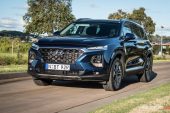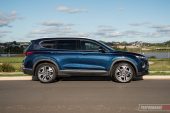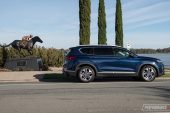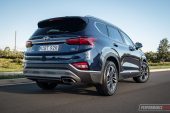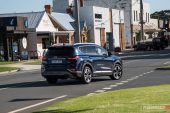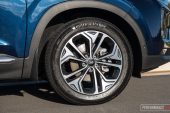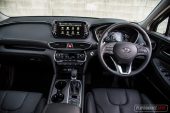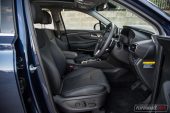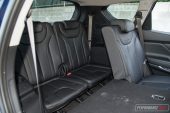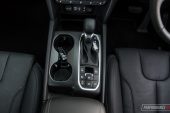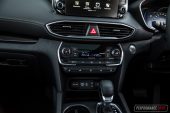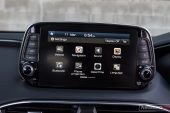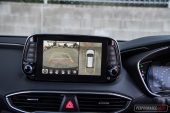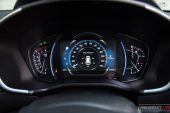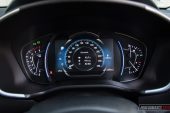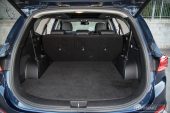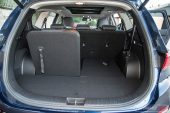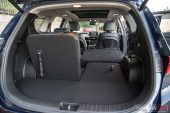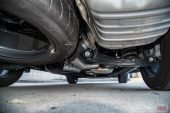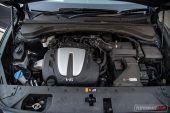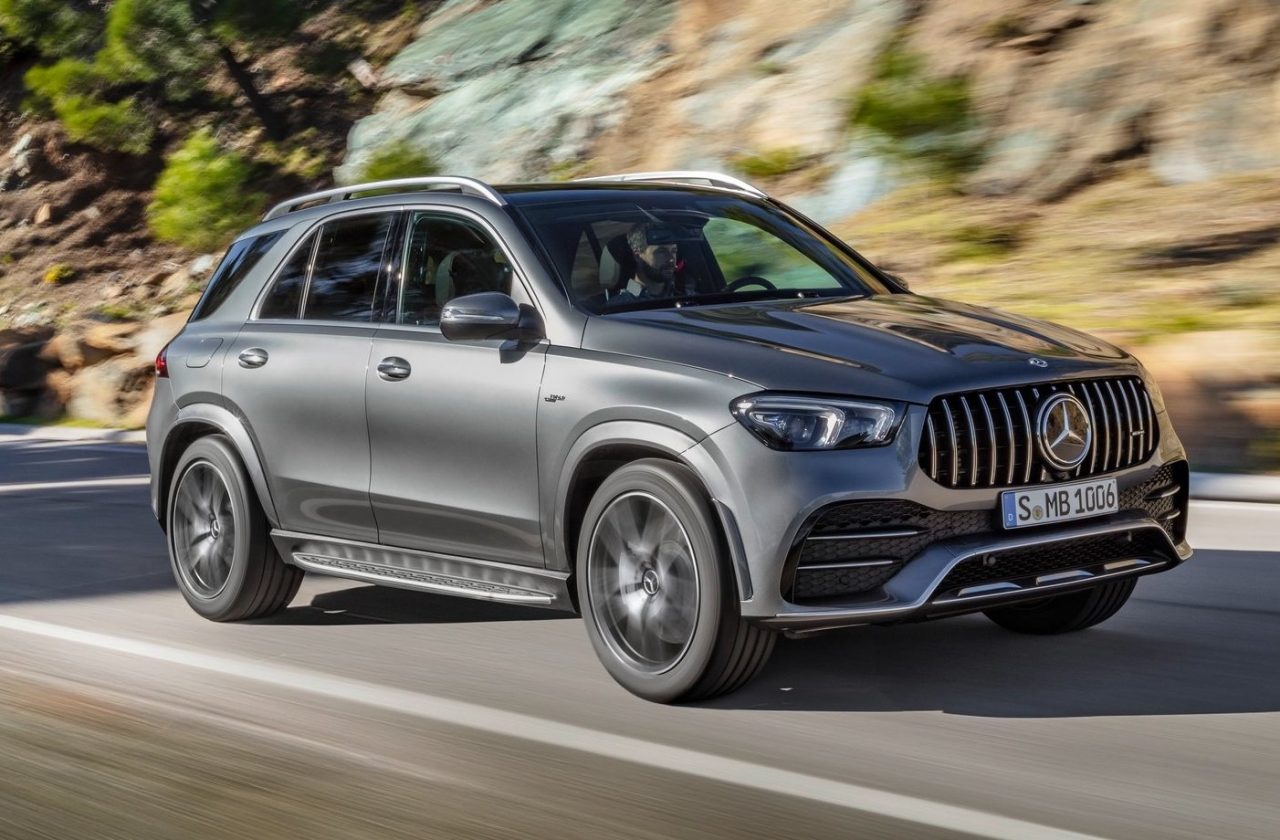Although diesel is usually the preferred choice for large SUV buyers, Hyundai Australia also offers a powerful V6 petrol option for its latest 2020 Santa Fe. Let’s check it out to see if it’s worth considering.
If you spend a lot of time out on the open road, sometimes big-capacity petrol engines can be surprisingly economical. So, we thought we’d sample the flagship Highlander V6 and take it for a run from Sydney down to Melbourne (our test took place prior to coronavirus restrictions) to see how it performs as a grand tourer.
Hyundai now offers the V6 for all three variants of the latest MY2020 Santa Fe, from Active, Elite to Highlander. It replaces the old 2.4 petrol. All V6 engines are paired with an eight-speed auto and front-wheel drive, while the 2.2-litre turbo-diesel four-cylinder, which is also available in all three trims, is matched to all-wheel drive as standard.
Prices start from $43,000 for the range-opening V6 Active, and top out at $60,500 for the diesel Highlander. Going for the V6 cuts the price by $3000 in all three (excluding on-road costs).
2020 Hyundai Santa Fe Highlander V6 – THE SPECS
[column width=”47%” padding=”6%”]Engine: 3.5-litre V6
Output: 206kW@6300rpm / 336Nm@5000rpm
Transmission: Eight-speed auto
Drive type: Front-wheel drive
Wheels: F: 19×8.0, 235/55
ANCAP: Five stars
Tare weight: 1799kg
Power-to-weight: 8.73:1 (kg:kW)
Official fuel economy: 10.6L/100km
Economy during test: 9.0L/100km
Fuel capacity/Type: 71L/91 RON[/column] [column width=”47%” padding=”0″]Power efficiency: 19.43kW:L/100km
0-60km/h: 3.96 seconds*
0-100km/h: 8.27 seconds*
60-110km/h: 5.62 seconds*
1/4 mile: 15.95 seconds at 146.9km/h*
Max acceleration: 0.574g
100-0km/h braking: 2.88 seconds at 36.14 metres*
Max deceleration: -1.221g
Decibel at idle: 39*
Peak decibel at 60-100km/h: 81*
Priced from: $58,050[/column][end_columns]
* Figures as tested by PerformanceDrive on the day. Factory claims may be different
2020 Hyundai Santa Fe Highlander V6 – THE PACKAGE
The latest Santa Fe interior represents a blend of modern design, a good mix of materials and quality, as well as excellent packaging and the availability of useable space. Up front are a pair of softly-cushioned seats with surprisingly prominent side bolsters helping to restrain lateral body movement during cornering. There’s plenty of adjustment available from both the seat and steering column so it is easy to find a good driving position.
What’s always great about modern Hyundai vehicles is the sheer ease of use. Button placement and the positioning of the major controls are all within reach and clearly marked. We find the centre console particularly convenient, with its dual cup holders and nice big, rubber-padded wireless phone charger platform at the front. There’s also a couple of charging port options right there, including USB and a 12V socket.
Up on the dash, above the dual-zone climate control panel, is an 8.0-inch touch-screen media interface for the Highlander (lower grades get a 7.0-inch screen). It isn’t Hyundai Motor Group’s latest system, with a 10.25-inch unit set to be introduced for the 2021 Santa Fe, but it does come packed with Android Auto and Apple CarPlay. You also get digital radio, sat-nav, and a surround-view camera system as standard. Some of these features are costly options on equivalent premium vehicles.
Rear seat passengers are well catered for as well. The middle row offers expansive legroom and the entire bench can slide forward or back, and recline, to open up even more room depending on the third row priorities. On the back of the console there are climate vents and dual USB ports, and even a little pocket which is a perfect place for your phone while it’s charging.
Third row accommodation is decent for this class, but not quite at the top in regards to legroom. It is best-suited to children, although the space is adequate for small to medium-size adults. Dual cup holders are formed in the plastic moulding of the left rear wheel arch, and there is a full climate control knob and a 12V socket available for added convenience.
Boot space measures in at 547 litres for front-wheel drive/V6 models in five-seat-up configuration, while the AWD/diesel offers 518L due to space occupied by the rear axle. Flip down the second row of seats and the space grows to 1625L. This puts it at the smaller end of the 7-seat SUV market segment: Kia Sorento 2WD (605L/1662L), Mazda CX-9 2WD (810L/1641L), Nissan Pathfinder 2WD (1354L/2260L), and Toyota Kluger 2WD (529L/1862L).
2020 Hyundai Santa Fe Highlander V6 – THE DRIVE
Under the bonnet is a 3.5-litre naturally aspirated V6, which is also shared with some variants of the current (pre-2021) Kia Sorento. It is a fairly old engine now, lacking some high-tech componentry that’s available in modern engines, such as direct injection. Instead, it comes with multi-point injection. The compression ratio is a conservative – for a naturally-aspirated unit – 10.6:1.
Peak power is rated at a strong 206kW, reached at 6300rpm. Meanwhile the torque peaks at just 336Nm, at 5000rpm. It likes to rev, and it revs up smoothly and quickly. But this engine can seem a bit mismatched for this style of vehicle. As the on-paper figures suggest, you need to rev it out to utilise what it has to offer. That torque number is also lowly for a 1800kg vehicle, and around 100Nm down on the 2.2 turbo-diesel option.
We have no major complaints about the engine on its own but it just doesn’t seem the best-suited for a 7-seat SUV. A great example of this concern is mostly evident out on the motorway. The eight-speed auto transmission hunts around a lot to find that peaky torque band, especially if you leave it in D and let the cruise control take over. We have a suspicion that this transmission is the same as the one fitted to the diesel, as it seems like not much calibration work has been done to adapt to the petrol.
Across the 0-100km/h sprint this powertrain does perform more than adequately for this market. We clocked a best time of 8.27 seconds. As expected, and as it should, that is quicker than what we’ve achieved in the diesel (9.82 seconds). So if it’s outright performance you want then the V6 is the obvious pick.
Putting aside the performance the Santa Fe is an excellent grand tourer, chiefly thanks to the Aussie-tuned suspension. Shoddy bitumen and undulating highways are no challenge at all. The suspension is very absorbent and casually soaks up imperfections, resulting in a cloud-like ride. In fact, road trips with the kids will be a breeze as they will probably nod off to sleep in no time.
With a soft and cushy suspension setting it does mean the resistance to body lean is relaxed and, at times, overly flexible. You can turn in with some vigour and the chassis does respond with reasonable enthusiasm, while the 235/55 Continental ContiSportContact 5 tyres hang on dependably. But it is lucky the front seats are well-bolstered as the body roll, particularly during swift directional changes, can become arduous.
Under power, pulling away from corners, we experienced noticeable torque-steer as well. Even though all-wheel drive would add more weight it’d be interesting to see how the Santa Fe would handle with the V6, with this suspension, and with AWD. We’d be guessing the torque-steer would be eradicated. It’s not enough to put you off – we actually find it amusing – but some very conservative drivers could see it as instability.
Now, clearly this isn’t a vehicle that you buy to attend track days. However, we think the setup is a lot more skewed toward sheer comfort than sportiness and agility. There are other SUVs in this specific segment that do provide a sportier character but then they are not quite as comfortable. Of course, there are also heavy-duty options available in this space that possess crude on-road characteristics but showcase great off-road capability. It all comes down to your preference and priorities.
During our interstate trip the Santa Fe shone the brightest in the area of sheer comfort, with its pleasant and practical in-car environment really coming in handy for so many hours on the road. Over the return trip, covering 2357km, we averaged 9.0L/100km (official average is 10.6L/100km). It’s not as economical as the diesel, which offers an official average of 7.5L/100km and a highway rate of 6.2L/100km, but the smoothness and quietness of the V6 does enhance the Santa Fe’s grand touring ability.
2020 Hyundai Santa Fe Highlander V6 – THE VIDEO
2020 Hyundai Santa Fe Highlander V6 – THE VERDICT
We like to describe the Santa Fe V6 as the modern-day alternative to the old Ford Falcon; it’s big and very comfortable, a bit cushy during cornering but also extremely friendly on the inside. The interior is almost like a family room, providing suitable facilities for all members.
As for the V6, it is quicker than the diesel across the 0-100 sprint but in the real world the higher torque of the diesel makes it feel just as, if not more punchy. The diesel offers considerably more torque, which, to us, is handier in this type of vehicle than peaky power. The fuel consumption isn’t as bad as you might expect in the V6 but even still the diesel is more frugal as well.
So unless you live in the city and you’re worried about travelling really short distances regularly, which are known to be less than ideal circumstances for diesel engines, our recommendation is to stick with the popular trend and go for the 2.2 turbo-diesel option.
[column width=”47%” padding=”6%”]PROS:
– Family-friendly interior and packaging
– Good features list
– Great cross country tourer
– Aussie-tuned suspension, excellent ride comfort
– V6 is smoother and quieter than the diesel
[/column] [column width=”47%” padding=”0″]CONS:
– V6 only available with FWD
– Auto transmission doesn’t seem well calibrated for V6, hunts around (a lot)
– Comfortable ride means suspension can feel sloppy when under stress[/column][end_columns]
As always, if you’re thinking about buying a new car don’t forget to click here to speak with our car buying specialists.








